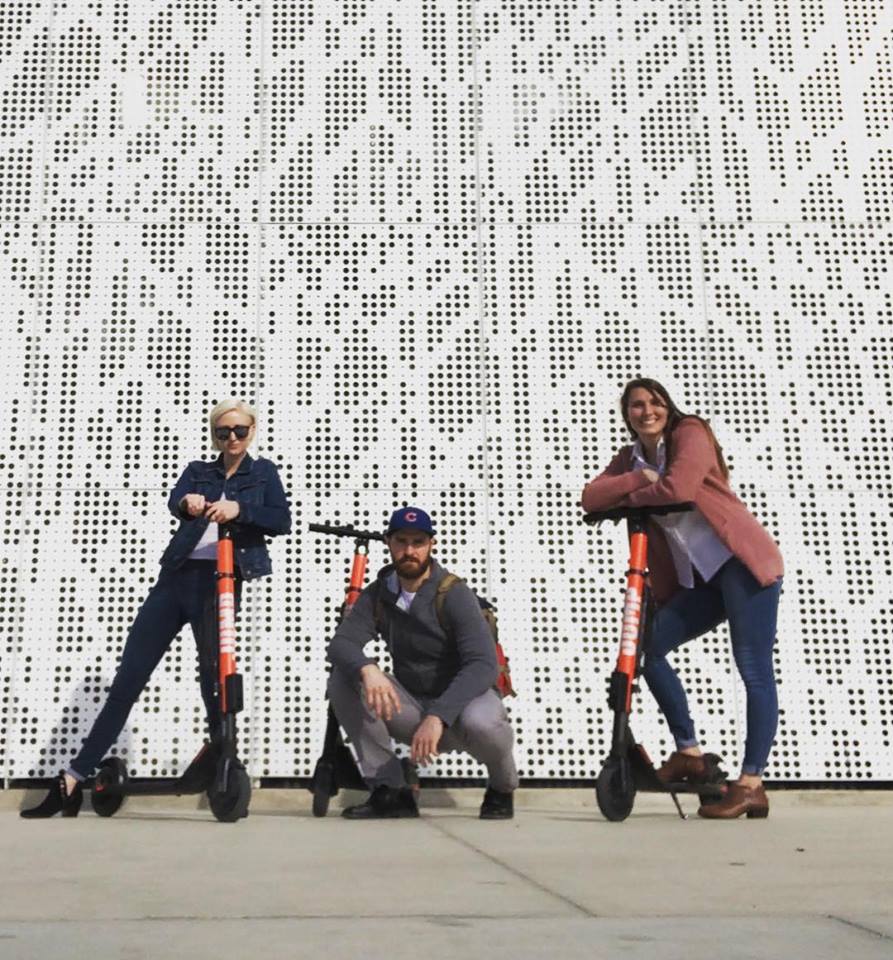The Association of Fundraising Professionals International Conference (AFP ICON) was this week! While we loved meeting our clients, talking to new people, and visiting the local attractions (and sampling the favorite local margarita spots), our favorite part of AFP ICON is all the amazing sessions.
We pulled some of the top tweets from AFP ICON’s sessions and included a takeaway for each. Look at all the amazing content we learned!
The Post
Using matte or low-gloss paper reduces glare, which makes appeals easier to read for senior eyes. #AFPICON
— qgiv (@qgiv) April 2, 2019
The Takeaway
Readability isn’t only a digital metric! Making direct mail appeals easy to read is important… especially since the majority of direct mail donors are seniors. We learned that using matte paper for appeals and updates is a simple way to make your appeals easier for seniors to read. Other readability tips included indenting paragraphs, making margins larger, using 14-point font (at a minimum!), and using high-contrast colors.
If you’re interested in other ways you can make it easier for seniors to donate, we can help! Here’s how to tweak your donation process to make it more accessible to everyone… including seniors!
The Post
Need a reason to call your donor to say thank you? Here’s a few!#AFPICON @hollyhpolly pic.twitter.com/nsAD9V6xeZ
— Sarah Willey, MA, CFRE, SMS TEDx Speaker she/her (@SarahNicole838) April 1, 2019
The Takeaway
Does contacting your donors to thank them for a gift really make a difference? Research says “yes!” Put an emphasis on thanking your donors in personal ways if you want to increase the odds of them giving again. We especially loved that donors who received a thank-you call within 24 hours usually gave 39% more the next time they gave. A 5-minute phone call results in a nearly 40% gift size increase?! Talk about a return on your investment!
Donor retention can seem intimidating. But don’t fret! Here’s an infographic that breaks down 5 donor-retention activities that will take you 5 minutes or less.
The Post
Fascinating! Use a credit card update service and you can make your monthly #giving program very successful! #fundraising #AFPICON @AFPIHQ pic.twitter.com/18pzN99EE7
— Gail Perry (@GailPerrync) April 1, 2019
The Takeaway
We all know the value of recurring donors. It makes sense to work on keeping them engaged! One way to do that is to use a credit card update service to prevent lapsed, expired, or replaced cards. They prevent hitches or delays in recurring payments, and it’s also a lot less work for your staff. Forget playing phone tag with someone to try to get their new card info: this does it for you!
Qgiv hint: if you’re using Qgiv, this is already available to you!
The Post
Donors want three things:
– A prompt, personal thank-you
– An understanding of where their money will go and how you’ll use it
– An update containing measurable, quantifiable reports on what their money achieved.#AFPICON— qgiv (@qgiv) April 1, 2019
The Takeaway
Ever wonder what donors want from the nonprofit they support? It’s this. This is what they want.
At one of the sessions we attended, the speaker told us that it’s not enough any more to just make donors feel good about their gift. Donors already feel good about their gift. Instead, treat your donors like investors. They’ve invested money in your cause. What did you accomplish with it? Share that with your donors. They’ll be more likely to give again if they feel their money accomplished something.
Don’t know where to start? That’s okay! Check out this blog article to see a great thank-you letter, understand why it works, and get a template that will get you started.
The Post
Fundraising consultant @rachelmuir says including photos in your automatic email replies is a “great way to stand out and be memorable.” (Another tip for fundraisers from Muir: Add your photo in your email signature, so that your donors will recognize and remember you.) #afpicon pic.twitter.com/WmXXqsF3ht
— Lisa Schohl (@LisaSchohl) April 2, 2019
The Takeaway
Pictures are powerful! Our BFF Rachel Muir (you can check out a couple recent webinars she’s done with us here and here) suggests putting pictures in two unusual places: in your automatic email replies and in your signatures.
We know we should include pictures on appeals, donation forms, thank-you pages, and receipts, but this tip is genius. Pictures can soften the often-impersonal process of sending automated email replies, and the bit about using signature photos to build face recognition is brilliant. This is a low-cost, low effort activity that can make a BIG impression!
Curious about other places to use good images? There’s a blog entry for that.
The Post
Gen Z and Millennials prefer to be called “advocates” or “allies” instead of “donors” or “supporters.”
Semantics moment: this implies they want to be seen as “coming alongside” others, not donating out of a sense of obligation or pity.#AFPICON
— qgiv (@qgiv) April 1, 2019
The Takeaway
Young donors (Millennials and Generation Z) don’t have as much spending power as their parents and grandparents… yet! But they are still passionate about nonprofits and the work they do. Gen Z is so philanthropic-minded that people call them “philanthro-kids!”
One big difference between young donors and their parents is that younger donors prefer to be called “advocates” or “allies.” In their mind, these donors aren’t giving to people out of pity, obligation, or a sense of “charity.” Instead, they view themselves as helping out their fellow humans. It’s a subtle difference, but it’s an important one… especially as we try to engage more and more young supporters as donors, volunteers, and even advisers.
Want to learn more about how to approach young donors? Here’s a blog entry written by a Millennial on how to reach us.
The Post
“Fundraising is not mining or hunting; it’s farming” #afpicon #gala #Fundraising pic.twitter.com/SZQRni8ASp
— Inspired Hearts (@iinspirehearts) March 31, 2019
The Takeaway
It’s tempting to think of fundraising as a game. And we still can… it’s just much more “Farmville” than “Battlefield.”
You don’t “win” fundraising when someone makes a gift. You “win” fundraising when someone gives loyally, over and over, gradually increasing their gift each time. A successful donor relationship doesn’t just result in a gift! It results in a lifelong partnership between you and your donors.
Psst: want to grow your relationships with your donors? We have an eBook for that! It’s even farm-themed! Download it here — Grow Your Giving: Donor Cultivation Strategies for Every Nonprofit.
The Post
First year retention rates for one-time gifts is 24%. First year retention rates for recurring gifts is 73%. Revenue per donor for single gifts is $108 and for for recurring gifts is $222. @SMacLaughlin #afpicon
— Chris LeBrun (@chrislebrun) April 1, 2019
The Takeaway
Ahem. Please listen to me: allow recurring donations. They’re (almost) literally the best thing since sliced bread. Donors who set up recurring donations are three times more likely to stick with you after their first year. Their annual contributions are generally more than double their one-time-gift-giving counterparts. They’re predictable revenue, which makes planning easier. PLEASE let people donate to you on a recurring basis!
Need to start a recurring giving program? No problem. Here’s an article on how to build your donation form to attract recurring donors. And here’s an article on how to turn 1-time donors into recurring donors.
The Post
If you want to make a big impact with a CTA, pose your photographs so the subject is looking at or pointing at the CTA. Donors will instinctively look where they are gesturing. #AFPICON pic.twitter.com/ZMIRcbasfS
— qgiv (@qgiv) April 1, 2019
The Takeaway
Not gonna lie: this one blew our minds a little bit. Humans are hardwired to take cues from other humans in our area…. including humans that are printed on an appeal or appear on a webpage.
In an experiment, researchers included a picture of a baby next to a “DONATE” button on two different web pages. On one, the baby was looking at the camera. On the other, the baby was looking at the CTA button. The second page attracted many more clicks on the CTA! On the first, people just made eye contact with the baby.
Want more image tips? Here’s how to add a hyperlinked image to your next email appeal.
The Post
Five exercises –> five stories
Do these exercises with your Board:
1) Why do I care?
2) Why should someone give?
3) What are we raising money for?
4) Killer short story about your work.
5) Wouldn’t it be wonderful if… @GailPerrync @LJacobwith #AFPICON— Julia Campbell (She/Her) #BlackLivesMatter 🏳️🌈 (@JuliaCSocial) March 31, 2019
The Takeaway
Getting your board members engaged in the fundraising process can be a nightmare. But is it any wonder? They’re not professional fundraisers. They don’t work with your organization full time — they have other jobs, instead. And they don’t often get to connect with your work on a daily basis like you do.
To help overcome those obstacles, get your board members engaged with storytelling exercises. Telling stories reconnects them with their passion, gets them excited about your work, and gives them room to dream about the future. Plus, any killer stories they tell can be used in future appeals, updates, and other communications.
Looking for other ways to get them more engaged? Here are some tips from a real-life fundraiser (now a real-life Qgiv writer) that will help you connect with your board. And here’s an article about how to engage board members using peer-to-peer fundraising. Yes, we’re serious.
Bonus Post
Thank you to the staff at @TexasMedClinic for taking care of me tonight.🚑
A fractured radial head in my elbow two-hours after being in town, was not how I planned on starting my time in San Antonio for #AFPICON. #BlameJosh pic.twitter.com/cmflVTMhf1— TheDudeAbidez.eth (@TheDudeAbidez_) March 30, 2019
Bonus Takeaway
You know those electric scooters that are popping up in cities across the country? They’re sinister. Be careful when you’re using them!

They’re still pretty fun, though.




